+ Open data
Open data
- Basic information
Basic information
| Entry | Database: EMDB / ID: EMD-23352 | |||||||||
|---|---|---|---|---|---|---|---|---|---|---|
| Title | Structure of the LRRK2 monomer | |||||||||
 Map data Map data | LRRK2 monomer | |||||||||
 Sample Sample |
| |||||||||
 Keywords Keywords | Parkinson's disease / microtubule / kinase / cryo-EM / NEUROPEPTIDE / TRANSFERASE / HYDROLASE | |||||||||
| Function / homology |  Function and homology information Function and homology informationcaveola neck / negative regulation of protein processing involved in protein targeting to mitochondrion / beta-catenin destruction complex binding / regulation of branching morphogenesis of a nerve / regulation of kidney size / Wnt signalosome assembly / regulation of cell projection organization / tangential migration from the subventricular zone to the olfactory bulb / GTP-dependent protein kinase activity / regulation of SNARE complex assembly ...caveola neck / negative regulation of protein processing involved in protein targeting to mitochondrion / beta-catenin destruction complex binding / regulation of branching morphogenesis of a nerve / regulation of kidney size / Wnt signalosome assembly / regulation of cell projection organization / tangential migration from the subventricular zone to the olfactory bulb / GTP-dependent protein kinase activity / regulation of SNARE complex assembly / regulation of neuroblast proliferation / regulation of ER to Golgi vesicle-mediated transport / protein localization to endoplasmic reticulum exit site / peroxidase inhibitor activity / negative regulation of late endosome to lysosome transport / regulation of mitochondrial depolarization / negative regulation of protein targeting to mitochondrion / positive regulation of dopamine receptor signaling pathway / amphisome / regulation of synaptic vesicle transport / regulation of CAMKK-AMPK signaling cascade / regulation of lysosomal lumen pH / co-receptor binding / negative regulation of GTPase activity / regulation of neuron maturation / regulation of dopamine receptor signaling pathway / positive regulation of microglial cell activation / regulation of retrograde transport, endosome to Golgi / positive regulation of synaptic vesicle endocytosis / cytoplasmic side of mitochondrial outer membrane / negative regulation of excitatory postsynaptic potential / negative regulation of autophagosome assembly / JUN kinase kinase kinase activity / olfactory bulb development / neuron projection arborization / striatum development / multivesicular body, internal vesicle / regulation of dendritic spine morphogenesis / mitochondrion localization / protein localization to mitochondrion / cellular response to dopamine / positive regulation of mitochondrial outer membrane permeabilization involved in apoptotic signaling pathway / positive regulation of protein autoubiquitination / endoplasmic reticulum organization / Wnt signalosome / negative regulation of protein processing / positive regulation of programmed cell death / GTP metabolic process / regulation of canonical Wnt signaling pathway / syntaxin-1 binding / regulation of reactive oxygen species metabolic process / lysosome organization / Golgi-associated vesicle / clathrin binding / protein kinase A binding / PTK6 promotes HIF1A stabilization / negative regulation of macroautophagy / regulation of locomotion / neuromuscular junction development / regulation of cAMP/PKA signal transduction / regulation of mitochondrial fission / regulation of synaptic vesicle exocytosis / microvillus / Golgi organization / exploration behavior / intracellular distribution of mitochondria / endoplasmic reticulum exit site / autolysosome / locomotory exploration behavior / negative regulation of Notch signaling pathway / MAP kinase kinase kinase activity / regulation of synaptic vesicle endocytosis / canonical Wnt signaling pathway / regulation of synaptic transmission, glutamatergic / negative regulation of endoplasmic reticulum stress-induced intrinsic apoptotic signaling pathway / presynaptic cytosol / Rho protein signal transduction / phagocytic vesicle / neuron projection morphogenesis / JNK cascade / cellular response to manganese ion / positive regulation of autophagy / tubulin binding / dendrite cytoplasm / GTPase activator activity / cellular response to starvation / positive regulation of protein ubiquitination / SNARE binding / determination of adult lifespan / cellular response to reactive oxygen species / regulation of membrane potential / mitochondrion organization / excitatory postsynaptic potential / trans-Golgi network / calcium-mediated signaling / regulation of protein stability / mitochondrial membrane / small GTPase binding / autophagy / endocytosis Similarity search - Function | |||||||||
| Biological species |  Homo sapiens (human) Homo sapiens (human) | |||||||||
| Method | single particle reconstruction / cryo EM / Resolution: 3.7 Å | |||||||||
 Authors Authors | Alexander M / Hanwen Z | |||||||||
| Funding support |  United States, 2 items United States, 2 items
| |||||||||
 Citation Citation |  Journal: Cell / Year: 2021 Journal: Cell / Year: 2021Title: Structural analysis of the full-length human LRRK2. Authors: Alexander Myasnikov / Hanwen Zhu / Patricia Hixson / Boer Xie / Kaiwen Yu / Aaron Pitre / Junmin Peng / Ji Sun /  Abstract: Mutations in leucine-rich repeat kinase 2 (LRRK2) are commonly implicated in the pathogenesis of both familial and sporadic Parkinson's disease (PD). LRRK2 regulates critical cellular processes at ...Mutations in leucine-rich repeat kinase 2 (LRRK2) are commonly implicated in the pathogenesis of both familial and sporadic Parkinson's disease (PD). LRRK2 regulates critical cellular processes at membranous organelles and forms microtubule-based pathogenic filaments, yet the molecular basis underlying these biological roles of LRRK2 remains largely enigmatic. Here, we determined high-resolution structures of full-length human LRRK2, revealing its architecture and key interdomain scaffolding elements for rationalizing disease-causing mutations. The kinase domain of LRRK2 is captured in an inactive state, a conformation also adopted by the most common PD-associated mutation, LRRK2. This conformation serves as a framework for structure-guided design of conformational specific inhibitors. We further determined the structure of COR-mediated LRRK2 dimers and found that single-point mutations at the dimer interface abolished pathogenic filamentation in cells. Overall, our study provides mechanistic insights into physiological and pathological roles of LRRK2 and establishes a structural template for future therapeutic intervention in PD. | |||||||||
| History |
|
- Structure visualization
Structure visualization
| Movie |
 Movie viewer Movie viewer |
|---|---|
| Structure viewer | EM map:  SurfView SurfView Molmil Molmil Jmol/JSmol Jmol/JSmol |
| Supplemental images |
- Downloads & links
Downloads & links
-EMDB archive
| Map data |  emd_23352.map.gz emd_23352.map.gz | 215.4 MB |  EMDB map data format EMDB map data format | |
|---|---|---|---|---|
| Header (meta data) |  emd-23352-v30.xml emd-23352-v30.xml emd-23352.xml emd-23352.xml | 15.9 KB 15.9 KB | Display Display |  EMDB header EMDB header |
| Images |  emd_23352.png emd_23352.png | 119.2 KB | ||
| Filedesc metadata |  emd-23352.cif.gz emd-23352.cif.gz | 7.2 KB | ||
| Archive directory |  http://ftp.pdbj.org/pub/emdb/structures/EMD-23352 http://ftp.pdbj.org/pub/emdb/structures/EMD-23352 ftp://ftp.pdbj.org/pub/emdb/structures/EMD-23352 ftp://ftp.pdbj.org/pub/emdb/structures/EMD-23352 | HTTPS FTP |
-Related structure data
| Related structure data |  7lhwMC  7lhtC  7li3C  7li4C M: atomic model generated by this map C: citing same article ( |
|---|---|
| Similar structure data |
- Links
Links
| EMDB pages |  EMDB (EBI/PDBe) / EMDB (EBI/PDBe) /  EMDataResource EMDataResource |
|---|---|
| Related items in Molecule of the Month |
- Map
Map
| File |  Download / File: emd_23352.map.gz / Format: CCP4 / Size: 421.9 MB / Type: IMAGE STORED AS FLOATING POINT NUMBER (4 BYTES) Download / File: emd_23352.map.gz / Format: CCP4 / Size: 421.9 MB / Type: IMAGE STORED AS FLOATING POINT NUMBER (4 BYTES) | ||||||||||||||||||||||||||||||||||||||||||||||||||||||||||||||||||||
|---|---|---|---|---|---|---|---|---|---|---|---|---|---|---|---|---|---|---|---|---|---|---|---|---|---|---|---|---|---|---|---|---|---|---|---|---|---|---|---|---|---|---|---|---|---|---|---|---|---|---|---|---|---|---|---|---|---|---|---|---|---|---|---|---|---|---|---|---|---|
| Annotation | LRRK2 monomer | ||||||||||||||||||||||||||||||||||||||||||||||||||||||||||||||||||||
| Projections & slices | Image control
Images are generated by Spider. | ||||||||||||||||||||||||||||||||||||||||||||||||||||||||||||||||||||
| Voxel size | X=Y=Z: 0.826 Å | ||||||||||||||||||||||||||||||||||||||||||||||||||||||||||||||||||||
| Density |
| ||||||||||||||||||||||||||||||||||||||||||||||||||||||||||||||||||||
| Symmetry | Space group: 1 | ||||||||||||||||||||||||||||||||||||||||||||||||||||||||||||||||||||
| Details | EMDB XML:
CCP4 map header:
| ||||||||||||||||||||||||||||||||||||||||||||||||||||||||||||||||||||
-Supplemental data
- Sample components
Sample components
-Entire : LRRK2
| Entire | Name: LRRK2 |
|---|---|
| Components |
|
-Supramolecule #1: LRRK2
| Supramolecule | Name: LRRK2 / type: complex / ID: 1 / Parent: 0 / Macromolecule list: #1 |
|---|---|
| Source (natural) | Organism:  Homo sapiens (human) Homo sapiens (human) |
-Macromolecule #1: Leucine-rich repeat serine/threonine-protein kinase 2
| Macromolecule | Name: Leucine-rich repeat serine/threonine-protein kinase 2 / type: protein_or_peptide / ID: 1 / Number of copies: 1 / Enantiomer: LEVO / EC number: non-specific serine/threonine protein kinase |
|---|---|
| Source (natural) | Organism:  Homo sapiens (human) Homo sapiens (human) |
| Molecular weight | Theoretical: 286.427656 KDa |
| Recombinant expression | Organism:  Homo sapiens (human) Homo sapiens (human) |
| Sequence | String: MASGSCQGCE EDEETLKKLI VRLNNVQEGK QIETLVQILE DLLVFTYSEH ASKLFQGKNI HVPLLIVLDS YMRVASVQQV GWSLLCKLI EVCPGTMQSL MGPQDVGNDW EVLGVHQLIL KMLTVHNASV NLSVIGLKTL DLLLTSGKIT LLILDEESDI F MLIFDAMH ...String: MASGSCQGCE EDEETLKKLI VRLNNVQEGK QIETLVQILE DLLVFTYSEH ASKLFQGKNI HVPLLIVLDS YMRVASVQQV GWSLLCKLI EVCPGTMQSL MGPQDVGNDW EVLGVHQLIL KMLTVHNASV NLSVIGLKTL DLLLTSGKIT LLILDEESDI F MLIFDAMH SFPANDEVQK LGCKALHVLF ERVSEEQLTE FVENKDYMIL LSALTNFKDE EEIVLHVLHC LHSLAIPCNN VE VLMSGNV RCYNIVVEAM KAFPMSERIQ EVSCCLLHRL TLGNFFNILV LNEVHEFVVK AVQQYPENAA LQISALSCLA LLT ETIFLN QDLEEKNENQ ENDDEGEEDK LFWLEACYKA LTWHRKNKHV QEAACWALNN LLMYQNSLHE KIGDEDGHFP AHRE VMLSM LMHSSSKEVF QASANALSTL LEQNVNFRKI LLSKGIHLNV LELMQKHIHS PEVAESGCKM LNHLFEGSNT SLDIM AAVV PKILTVMKRH ETSLPVQLEA LRAILHFIVP GMPEESREDT EFHHKLNMVK KQCFKNDIHK LVLAALNRFI GNPGIQ KCG LKVISSIVHF PDALEMLSLE GAMDSVLHTL QMYPDDQEIQ CLGLSLIGYL ITKKNVFIGT GHLLAKILVS SLYRFKD VA EIQTKGFQTI LAILKLSASF SKLLVHHSFD LVIFHQMSSN IMEQKDQQFL NLCCKCFAKV AMDDYLKNVM LERACDQN N SIMVECLLLL GADANQAKEG SSLICQVCEK ESSPKLVELL LNSGSREQDV RKALTISIGK GDSQIISLLL RRLALDVAN NSICLGGFCI GKVEPSWLGP LFPDKTSNLR KQTNIASTLA RMVIRYQMKS AVEEGTASGS DGNFSEDVLS KFDEWTFIPD SSMDSVFAQ SDDLDSEGSE GSFLVKKKSN SISVGEFYRD AVLQRCSPNL QRHSNSLGPI FDHEDLLKRK RKILSSDDSL R SSKLQSHM RHSDSISSLA SEREYITSLD LSANELRDID ALSQKCCISV HLEHLEKLEL HQNALTSFPQ QLCETLKSLT HL DLHSNKF TSFPSYLLKM SCIANLDVSR NDIGPSVVLD PTVKCPTLKQ FNLSYNQLSF VPENLTDVVE KLEQLILEGN KIS GICSPL RLKELKILNL SKNHISSLSE NFLEACPKVE SFSARMNFLA AMPFLPPSMT ILKLSQNKFS CIPEAILNLP HLRS LDMSS NDIQYLPGPA HWKSLNLREL LFSHNQISIL DLSEKAYLWS RVEKLHLSHN KLKEIPPEIG CLENLTSLDV SYNLE LRSF PNEMGKLSKI WDLPLDELHL NFDFKHIGCK AKDIIRFLQQ RLKKAVPYNR MKLMIVGNTG SGKTTLLQQL MKTKKS DLG MQSATVGIDV KDWPIQIRDK RKRDLVLNVW DFAGREEFYS THPHFMTQRA LYLAVYDLSK GQAEVDAMKP WLFNIKA RA SSSPVILVGT HLDVSDEKQR KACMSKITKE LLNKRGFPAI RDYHFVNATE ESDALAKLRK TIINESLNFK IRDQLVVG Q LIPDCYVELE KIILSERKNV PIEFPVIDRK RLLQLVRENQ LQLDENELPH AVHFLNESGV LLHFQDPALQ LSDLYFVEP KWLCKIMAQI LTVKVEGCPK HPKGIISRRD VEKFLSKKRK FPKNYMTQYF KLLEKFQIAL PIGEEYLLVP SSLSDHRPVI ELPHCENSE IIIRLYEMPY FPMGFWSRLI NRLLEISPYM LSGRERALRP NRMYWRQGIY LNWSPEAYCL VGSEVLDNHP E SFLKITVP SCRKGCILLG QVVDHIDSLM EEWFPGLLEI DICGEGETLL KKWALYSFND GEEHQKILLD DLMKKAEEGD LL VNPDQPR LTIPISQIAP DLILADLPRN IMLNNDELEF EQAPEFLLGD GSFGSVYRAA YEGEEVAVKI FNKHTSLRLL RQE LVVLCH LHHPSLISLL AAGIRPRMLV MELASKGSLD RLLQQDKASL TRTLQHRIAL HVADGLRYLH SAMIIYRDLK PHNV LLFTL YPNAAIIAKI ADYGIAQYCC RMGIKTSEGT PGFRAPEVAR GNVIYNQQAD VYSFGLLLYD ILTTGGRIVE GLKFP NEFD ELEIQGKLPD PVKEYGCAPW PMVEKLIKQC LKENPQERPT SAQVFDILNS AELVCLTRRI LLPKNVIVEC MVATHH NSR NASIWLGCGH TDRGQLSFLD LNTEGYTSEE VADSRILCLA LVHLPVEKES WIVSGTQSGT LLVINTEDGK KRHTLEK MT DSVTCLYCNS FSKQSKQKNF LLVGTADGKL AIFEDKTVKL KGAAPLKILN IGNVSTPLMC LSESTNSTER NVMWGGCG T KIFSFSNDFT IQKLIETRTS QLFSYAAFSD SNIITVVVDT ALYIAKQNSP VVEVWDKKTE KLCGLIDCVH FLREVTVKE NKESKHKMSY SGRVKTLCLQ KNTALWIGTG GGHILLLDLS TRRLIRVIYN FCNSVRVMMT AQLGSLKNVM LVLGYNRKNT EGTQKQKEI QSCLTVWDIN LPHEVQNLEK HIEVRKELAE KMRRTSVE UniProtKB: Leucine-rich repeat serine/threonine-protein kinase 2 |
-Macromolecule #2: GUANOSINE-5'-DIPHOSPHATE
| Macromolecule | Name: GUANOSINE-5'-DIPHOSPHATE / type: ligand / ID: 2 / Number of copies: 1 / Formula: GDP |
|---|---|
| Molecular weight | Theoretical: 443.201 Da |
| Chemical component information | 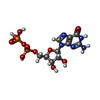 ChemComp-GDP: |
-Macromolecule #3: ADENOSINE-5'-TRIPHOSPHATE
| Macromolecule | Name: ADENOSINE-5'-TRIPHOSPHATE / type: ligand / ID: 3 / Number of copies: 1 / Formula: ATP |
|---|---|
| Molecular weight | Theoretical: 507.181 Da |
| Chemical component information |  ChemComp-ATP: |
-Experimental details
-Structure determination
| Method | cryo EM |
|---|---|
 Processing Processing | single particle reconstruction |
| Aggregation state | particle |
- Sample preparation
Sample preparation
| Buffer | pH: 8 |
|---|---|
| Vitrification | Cryogen name: ETHANE |
- Electron microscopy
Electron microscopy
| Microscope | FEI TITAN KRIOS |
|---|---|
| Image recording | Film or detector model: GATAN K3 (6k x 4k) / Average electron dose: 81.0 e/Å2 |
| Electron beam | Acceleration voltage: 300 kV / Electron source:  FIELD EMISSION GUN FIELD EMISSION GUN |
| Electron optics | Illumination mode: FLOOD BEAM / Imaging mode: BRIGHT FIELD |
| Experimental equipment |  Model: Titan Krios / Image courtesy: FEI Company |
 Movie
Movie Controller
Controller








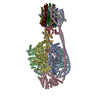
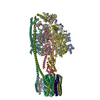

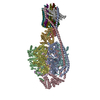


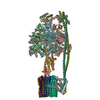








 Z (Sec.)
Z (Sec.) Y (Row.)
Y (Row.) X (Col.)
X (Col.)





















